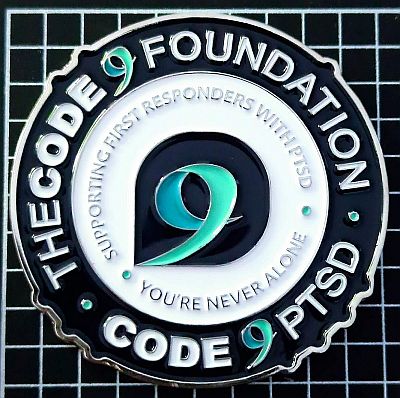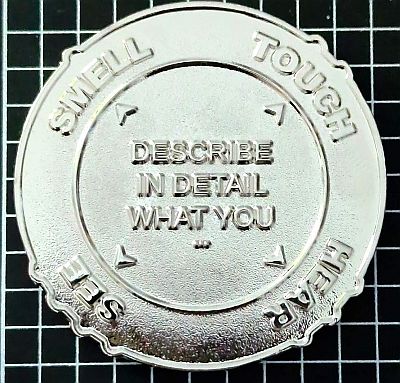A grounding tool to help first responders
The Code 9 Foundation
From Code9PTSD.org.au: “The Code 9 Foundation provides a place of support for current & veteran professional first responders & 000 operators (Emergency call takers)* who live with PTSD, depression, anxiety and other mental health conditions that result from their service to the community.
This support is available both in the ‘virtual world’ as well as via organised Peer to Peer ‘Catch-up’ nights, Coffee meet ups and other formal events.”
“Code 9” is the radio call police in Victoria, Australia use meaning “Police Require Urgent Assistance”.
The Code 9 Foundation is a registered charity in Australia and donations are encouraged to support their cause.
Obverse

The obverse of the coin is coloured in the teal-aqua-blue colours of the Code 9 Foundation. It contains the name of the foundation and the cause “Supporting first responders with PTSD” and “You’re never alone”.
The coin is large and weighty, making it noticeable while holding, helping to focus on the objective. All of the text is 3d making the coin quite tactile. It’s 52mm diameter with the four sets of bumps around the edge, 3mm thick and weighs 30.5 grams.
Reverse

The reverse of the coin contains the instructions. In the centre “Describe in detail what you”, with arrows pointing in four directions:
- Smell (with one bump on the coin’s edge)
- Touch (with two bumps)
- Hear (three bumps)
- See (four bumps)
Indicating to describe in detail one thing you can smell, two things you can touch, three things you can hear and four things you can see.
This is a commonly used grounding technique which can be very helpful during periods of anxiety or panic. It helps to ground you in the present. There are numerous variations which may vary the order of the senses / number of suggestions. All of them have the same goal and broad technique.
Emergency telephone numbers
*I went to put a note after the “000” phone number in the description at the start of the piece, then went down a rabbit hole reading about emergency telephone numbers. So I thought I’d seperate it out down here. 000 is the emergency telephone number in Australia. The International Telecommunications Union has officially set 112 (used in Europe) and 911 (Used in North America) as the two standard emergency numbers. Countries should ideally use one of these in future – either as a new number or a secondary number. For instance, in Australia 000 is recommended, however 112 will also work.
999 was the first emergency number. It was introduced in the UK in 1937. There has been ongoing discussion as to why 999 was chosen, but in the end, as with emergency numbers used in other countries, it is a simple to remember number. Thanks to TV and pop-culture, 911 is probably the most widely recognised emergency number today, although it is only guaranteed to work in North America. The first 911 call in the United States was made in 1968.
Supporting Code 9

The “Senses” challenge coin is available from the Code 9 Foundation. The cost is $20 AUD (you may need to contact Code 9 to confirm postage rates outside Australia).
Do you know of any other practical, grounding tool coins supporting charities such as Code 9? Or challenge coins supporting other charities in general? Please do let us know.


Leave a Reply